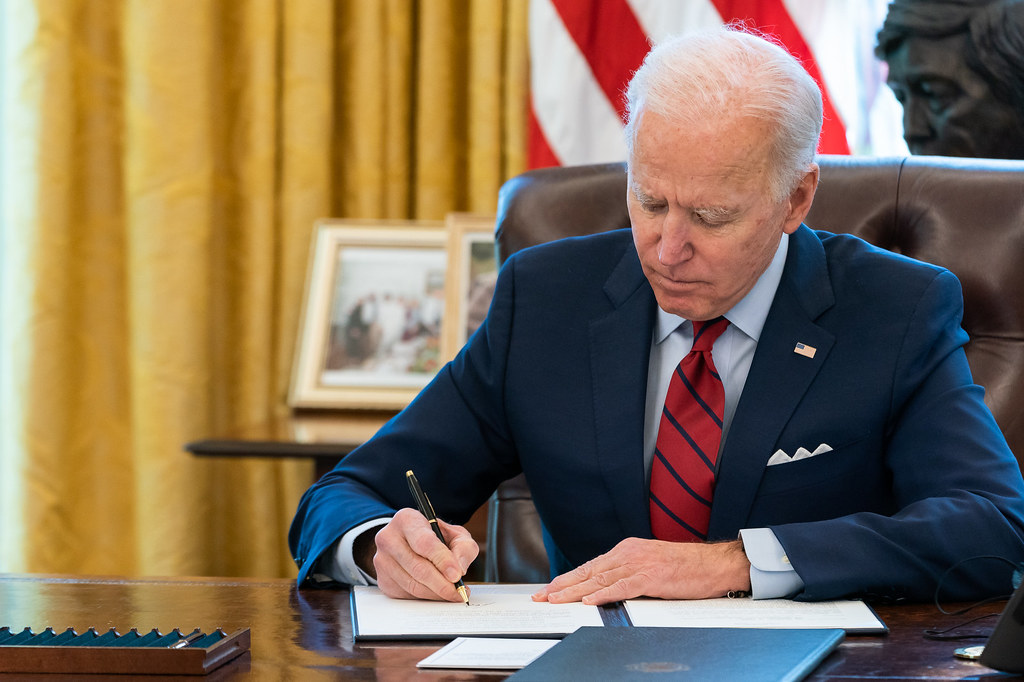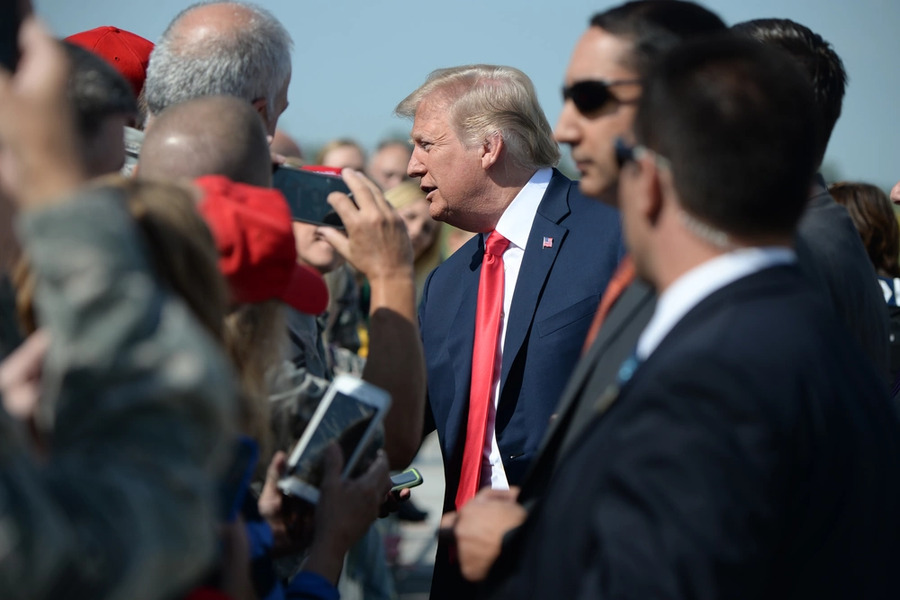The Strategic and Legal Implications of Biden’s New China Sanctions
An examination of the implications of Biden’s new China sanctions.

Published by The Lawfare Institute
in Cooperation With

The Biden administration has steadily developed its grasp on the U.S.-China relationship. Secretary of State Antony Blinken and National Security Adviser Jake Sullivan met with their Chinese counterparts for the first time in March 2021. Special Presidential Envoy for Climate John Kerry completed his first sit-down with Chinese climate officials during a visit to Shanghai in April. And last month, Kurt Campbell, the National Security Council coordinator for Indo-Pacific affairs, announced that the era of “engagement” with China had “come to an end,” and that the “dominant paradigm” between the United States and China is now one of competition.
In line with this paradigm, on June 3, the administration released its “Executive Order on Addressing the Threat from Securities Investments that Finance Certain Companies of the People’s Republic of China” (Executive Order 14032) to revise the sanctions levied against companies tied to China’s defense sector. That same day, the U.S. Department of Defense released a list of companies that are “owned, controlled, or acting on behalf of” the Chinese military or are “military-civil fusion contributors,” as required by Section 1260H of the National Defense Authorization Act (NDAA) for fiscal year 2021. What follows is an examination of the changes created by Executive Order 14032, and the strategic and legal implications they have for the U.S.-China relationship, as well as the existing statutory framework around Chinese military companies.
Executive Order 14032 (or the new Executive Order 13959)
A flurry of activity preceded Biden’s new sanctions. We covered much of the backstory in previous Lawfare posts, but to recap briefly: On June 24, 2020, the Defense Department released a list of “Communist Chinese military companies” (CCMCs) under Section 1237 of the 1999 NDAA. The release came in response to congressional pressure due to 20 years of noncompliance from the executive branch with Section 1237. That provision requires the department to identify those companies that are “owned, controlled by, or affiliated with” the People’s Liberation Army (PLA).
On Nov. 12, 2020, the Trump administration followed up the release by declaring a national emergency under the International Emergency Economic Powers Act (IEEPA) through Executive Order 13959, which prohibited “transactions in publicly traded securities” involving CCMCs after Jan. 11, 2021. On Jan. 13, then-President Trump signed Executive Order 13974, which amended Executive Order 13959 to prohibit U.S. persons from possessing CCMC securities longer than 365 days after the company was designated.
Congress also acted during this time by passing Section 1260H of the 2021 NDAA, which supplements the reporting obligations of the Defense Department regarding Chinese military companies. Soon after, two companies designated as CCMCs, Xiaomi and Luokung, filed suit in federal court contesting their designations. Each company quickly won its application for a preliminary injunction—Xiaomi on March 12, and Luokung on May 5. This prompted the new administration to agree to remove Xiaomi from the CCMC list, and likely helped prompt the new administration’s recalibration of Executive Order 13959, as detailed below.
What Stays the Same
One of us predicted in March that the Biden administration wasn’t likely to rescind the sanctions laid out in Executive Order 13959, and this ended up being largely correct: The new executive order keeps certain aspects of the status quo in place, including the sanctions themselves, the declaration of a national emergency under IEEPA, and the application of the sanctions only to securities traded by U.S. persons. In addition, like the original Executive Order 13959, the new order has a grace period before the sanctions go into effect. For the 59 companies listed in the executive order’s annex, the sanctions take effect on Aug. 2, 2021. For companies not yet listed, the sanctions take effect 60 days after the companies are designated. U.S. citizens have until June 3, 2022, to divest themselves of securities for companies currently on the list, and for companies designated in the future, they have a year after that designation occurs.
What Changes
With the new executive order, Biden expands the existing national emergency under Executive Order 13959, and in so doing revises much of the previous structure. First, the new order’s focus is slightly different. While the original version of Executive Order 13959 focused heavily on China’s military-civil fusion (MCF) strategy—by which “companies, though remaining ostensibly private and civilian, directly support the PRC’s military, intelligence, and security apparatuses”—this version (and the accompanying fact sheet) places greater emphasis on China’s “military-industrial complex,” with only a passing reference to the MCF strategy.
This change impacts the criteria to designate companies for sanctions. Section 1(a) of the new executive order explains that a person (an individual or an entity) can be sanctioned if they
operate or have operated in the defense and related materiel sector or the surveillance technology sector of the economy of the PRC; or they
own or control, or [are] owned or controlled by, directly or indirectly, a person who operates or has operated in any sector” described above, or are listed in the annex.
Some commentators have noted that changes in the new executive order put the sanctions on firmer legal footing. Along with this, some news reports have implied that the order’s transfer of authority to list companies as eligible for sanctions from the Defense Department to the Treasury Department is what places these sanctions on surer legal footing.
But the news reports mischaracterize the change. Section 4(a)(iii) of the original Executive Order 13959 gave the Treasury Department this authority from the beginning. Rather, it is the new executive order’s focus on certain sectors of the Chinese economy—instead of the Pentagon’s list of companies under Section 1237—that avoids the litigation concerns discussed above, and makes the Defense Department’s involvement less necessary. This helps to better insulate the new sanctions from being rendered ineffective due to companies successfully challenging their designations as CCMCs by the Pentagon. The new order concludes by revoking Executive Order 13974 (which, as noted above, amended Executive Order 13959) in its entirety.
The new order’s focus on “surveillance technology,” according to the fact sheet, is designed to target “firms that contribute—both inside and outside China—to the surveillance of religious or ethnic minorities or otherwise facilitate repression and serious human rights abuses,” a not-so-subtle reference to China’s treatment of Uighur Muslims in Xinjiang. This is a welcome update to the China sanctions regime, as surveillance is a key tool in the Chinese Communist Party’s efforts to control not only the Uighurs but also the majority Han population.
Implications and Concerns
Some observers have lauded the new executive order for the “clarity” it provides. But the terms of the order raise several concerns.
From MCF to the “Military-Industrial Complex”
To start, the administration’s emphasis on China’s “military-industrial complex” (and “Chinese military-industrial complex companies”) could send the wrong message compared to the previous focus on China’s MCF strategy. Concentrating on the MCF strategy allows the U.S. government to contextualize Chinese companies within the system that Beijing has created for them. Certain Chinese firms maintain more intimate ties to the Chinese defense apparatus, while others simply exist in a system where their resources, information, and intellectual property may be subject to exploitation by the Chinese party-state. This is the essence of MCF, and why there is a need for more nuanced language.
Divorcing the sanctions from China’s MCF strategy weakens the policy rationale behind them, and puts the administration in the position where it assesses Chinese firms through the U.S. lens of the military-industrial complex, rather than the uniquely Chinese lens of MCF. The U.S. government understandably might want to avoid using Chinese nomenclature in the new executive order’s definition, as this could allow China to change or shift definitions to avoid these sanctions. However, there are ways to address this while avoiding mirror-imaging, and accurately and effectively laying out the relationships between Beijing’s MCF strategy and Chinese companies.
Furthermore, due to this broadening of the executive order’s focus, the extent of the sanctions coverage is unclear. While the order’s annex provides an initial list of covered companies, the terms “defense and related material sector” and “surveillance technology sector” are not defined. The original Executive Order 13959 targeted only those covered by Section 1237 of the 1999 NDAA. But the new order reaches far more areas of Chinese society.
The lack of fixed definition could lead to a much wider net being cast than is useful. Take, for example, a Chinese student at a Chinese state-run university who launches a startup blockchain company based on work done in a university research center, before becoming naturalized in the United States. Under the new rules, there’s a risk that this company could be prevented from going public on the New York Stock Exchange due to the “defense and related material” provision in the new executive order. Beijing announced on June 6 through its Ministry of Industry and Information Technology that it wants to become a world leader in blockchain, a technology that has numerous defense-related applications, by 2025. Indeed, specialists in the Chinese military have recently proposed using blockchain for everything from paying intelligence operatives to rewarding troops for improved performance.
Cutting off an avenue for potential Chinese immigrants to benefit from their work could have a chilling effect on attracting innovative Chinese talent to the United States, and thus an adverse effect on U.S. economic competitiveness. While the executive order’s initial list would indicate a focus on large semiconductor, infrastructure, and defense production companies, the reality is that companies can be designated or removed based solely on the Treasury Department’s understanding of what each sector encompasses. The Office of Foreign Assets Control (OFAC) can do a lot toward clearing this up in its FAQs.
The Pentagon’s Lists
The executive order’s new focus begs the question of what happens to the Pentagon’s lists under Sections 1237 and 1260H. We explained last month that both lists effectively “name and shame” Chinese MCF behavior. But we also explained that Congress meant for the president to create sanctions—either through Section 1237(a) or by declaring a national emergency—based on these lists once they had been issued. The currently pending American Financial Markets Integrity and Security Act, introduced by Sen. Marco Rubio in 2020, for example, would codify such sanctions into law.
Executive Order 14032 opts not to lean on the Section 1237 list. This is understandable given the ongoing litigation surrounding Section 1237. But it could have relied instead on Section 1260H’s well-tailored MCF definitions—especially since the Pentagon released its 1260H list within hours of the new sanctions being announced, following pressure from Sen. Tom Cotton and other members of Congress. That list has not been the subject of litigation, and it would reach a healthy majority of the companies listed in Biden’s order. Even if the executive branch simply wished to avoid using congressionally defined categories, it could have used Section 1260H as a guide to create more tailored categories of its own.
It’s true that, absent mention of Sections 1237 and 1260H, companies like Huawei, Hikvision, Panda Electronics and Inspur are still covered by the new sanctions. But Sugon—which produces semiconductors used to help monitor Uighurs—and 15 other companies from the Pentagon’s 1237 list are not: the CRRC Corporation, the China National Chemical Engineering Company, the China National Chemical Corporation, Sinochem, the China State Construction Group Company, the China Three Gorges Corporation, the China Construction Technology Company, the China International Engineering Consulting Corporation, Advanced Micro-Fabrication Equipment, the Beijing Zhongguancun Development Investment Center, GOWIN Semiconductor Corporation, the Grand China Air Company, the Global Tone Communication Technology Company, China National Aviation Holding Company, and the Commercial Aircraft Corporation of China.
Their absence at present is particularly striking because many of these firms should be considered as operating in the “defense and related material” sector of the Chinese economy. For example, CRRC Corporation subsidiaries have reportedly supplied the PLA with relevant semiconductor technology that may have aided in the development of rail gun technology. In addition, some well-known firms that should easily qualify under the “surveillance technology sector” paradigm, like DJI, CloudMinds, and SenseTime, also aren’t listed. And while the new Section 1260H list only identifies the China State Shipbuilding Corporation (CSSC), the new executive order continues the trend from the Section 1237 list of itemizing both CSSC and the China Shipbuilding Industry Corporation (CSIC), despite their 2019 merger. This is possibly due to CSSC and CSIC continuing with distinct structures under the umbrella of the China Shipbuilding Group Company, and the executive order wanting to reach all possible activity.
Subsidiaries
The current focus on subsidiaries in the Pentagon’s 1260H list and the executive order’s annex is likely reflective of the fact that the majority of large, state-owned Chinese parent companies have little to no equity in U.S. markets, whereas subsidiaries tend to have a larger overseas presence, as outlined by a November 2020 report from RWR Advisory Group. The government’s choice to opt for listing subsidiaries along with parent companies could also demonstrate that subordinate firms maintain closer or more specific ties to the PLA than their parent companies. This would dovetail with both the targeted nature of the definitions in Section 1260H and OFAC’s new rules on the China sanctions.
OFAC has indicated that a subsidiary is covered by the new sanctions “only if such subsidiary itself is publicly listed” by the Treasury Department. However, not all relevant subsidiaries are currently sanctioned: While the subsidiaries of the Semiconductor Manufacturing International Corporation (SMIC) are on the Pentagon’s Section 1260H list because they are connected to the Chinese military, they are not listed in the new executive order’s annex, though SMIC itself is.
And then there is the China National Aero-Technology Import & Export Corporation (CATIC), which is not on any of the lists. A subsidiary and representative of the Aviation Industry Corporation of China (AVIC) in various international markets for the sale of military equipment, CATIC has been the subject of a 1990 presidential divestment order after a finding from the Committee on Foreign Investment in the United States that a proposed merger posed a danger to U.S. national security; a 1999 indictment for alleged violations of export-control laws related to military hardware; and sanctions by the State Department in 2004, 2005 and 2006 for nuclear proliferation activities in Iran. And its sister company, AVIC International, has acquired numerous U.S. companies, including in aviation. AVIC, the parent company of both CATIC and AVIC International, is on both of the Pentagon’s lists and on the executive order’s list.
If the administration’s goal is to “prevent U.S. investment from supporting the Chinese defense sector,” and target “the surveillance of religious or ethnic minorities,” then leaving subsidiaries that both the Pentagon and other elements of the U.S. government have identified as being connected to the Chinese military off the sanctions list seems to not go far enough.
Divestment and Executive Order 13974
Finally, as noted above, the new order revokes Executive Order 13974 in its entirety. Other commentators have presented as potentially significant the fact that the language in Section 1(c) of the new order means that Americans are not “affirmatively required” to divest themselves of securities after the new 365-day period—as they were under Executive Order 13974—but are merely “permitted” to do so. However, Americans would still be subject to the prohibitions in the order even after the year to divest had expired, so the distinction isn’t ultimately all that consequential.
Conclusion
As the Biden administration has moved forward on Chinese military companies, so has Congress. For instance, in addition to Sen. Rubio’s bill mentioned above, Congress tucked two provisions on Sections 1237 and 1260H deep into the recently Senate-passed U.S. Innovation and Competition Act (formerly known as the Endless Frontier Act). Section 2502 would prohibit companies on the Pentagon’s lists from participating in grants, awards and other programs outlined in the act, while Section 5302 requires a report from the president on the malign activities of Chinese state-owned enterprises, including by identifying any companies covered under Section 1237.
Even so, there appears to be a disconnect between Congress and the executive branch on jurisdiction, approach and intended impact in this area. To craft the most effective policy against the “pacing threat” of China, the sanctions and lists should be clear and deconflicted. The U.S. government should also use this framework to emphasize economic competitiveness in addition to defense, since the MCF strategy aims to improve China’s global standing both militarily and economically. Failing to address both sides of the MCF coin will only result in an ineffective strategy, as it misunderstands a key component of China’s MCF drive.
Biden’s sanctions, and the reporting regime surrounding Chinese military companies, are tools that are being fleshed out as the U.S. government settles on a clear-eyed strategy to compete with China in conjunction with U.S. allies. Sometimes these tools will take the form of proactive measures like the U.S. Innovation and Competition Act, and other times it will mean taking a longer view, with actions like Biden’s new executive order mandating a review of apps like TikTok and WeChat for security risks. While much remains uncertain, including the outcome of pending litigation, one thing is clear: This isn’t the last word on Chinese military companies.






